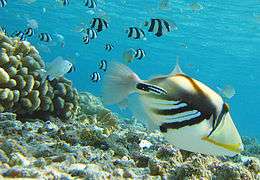Lagoon triggerfish
| Lagoon triggerfish | |
|---|---|
 | |
| Scientific classification | |
| Kingdom: | Animalia |
| Phylum: | Chordata |
| Class: | Actinopterygii |
| Order: | Tetraodontiformes |
| Family: | Balistidae |
| Genus: | Rhinecanthus |
| Species: | R. aculeatus |
| Binomial name | |
| Rhinecanthus aculeatus (Linnaeus, 1758) | |
The lagoon triggerfish (Rhinecanthus aculeatus), also known as the blackbar triggerfish, the Picasso triggerfish, the Picassofish, and the Jamal, is a triggerfish, up to 30 cm in length, found on reefs in the Indo-Pacific region.
The Hawaiian name for the fish, humuhumunukunukuāpuaʻa (pronounced [ˈhumuˈhumuˈnukuˈnukuˈwaːpuˈwɐʔə]), also spelled humuhumu-nukunuku-a-puaʻa or just humuhumu for short (meaning "triggerfish with a snout like a pig"[1]) shares the same name with the reef triggerfish, the state fish of Hawaii.
This species has been studied in a range of research contexts, from locomotion to colour vision research.
Behavior
Lagoon triggerfish live in the reefs and sandy areas of coral reefs where it eats just about everything that comes along. They are always restlessly swimming around and can vigorously protect their territory against intruders, including divers, especially when guarding their eggs during reproduction season. Fortunately, their relative small size makes them much less dangerous than the larger titan triggerfish of the same family.
Mating and reproduction
Both sexes guard territories, some maintaining a territory for eight years or longer (males holding territories for significantly longer than females). A typical male territory may overlap with one to five female territories, and their mating system is described as haremic, although not much is known about this (similar mating systems are seen in other Balistidae species). If a male or female is removed or disappears their territories are soon taken over by a new fish. They reproduce repeatedly over their lifetimes.[2]
Pair-spawning takes place around sunrise, with the egg masses being attached to sand, coral rubble or algae. They hatch the same day around sunset. Although paternal care is normal in teleost fishes with external fertilization, it is the mothers in this species that guard and care for eggs until they hatch. The mother remains above the eggs for about 12–14 hours, fanning the eggs with her pectoral fins to improve aeration for perhaps 30% of the time. She chases away most fish that approach and remove other intruders like starfish by mouth. Maternal care is effective in preventing predation, and experimental removal of the mothers reduced survival to almost nothing suggesting this behaviour is adaptive. Unlike fathers, mothers forage less and over a smaller area near the egg mass while caring for the eggs. Since the males have multiple mates, caring for an egg mass would probably be more costly in terms of lost mating opportunities so maternal care is considered to be an evolutionarily stable strategy.[2]
Vision
This species has one type of single cone (SC), with visual pigment peaking in sensitivity at 413 nm (S),[3] and a double cone with different visual pigments in each member peaking at 480 nm (M) and 530 nm (L) respectively.[4] Behavioural research has provided evidence that individual members of the double cones can act as independent channels of colour information, aiding in understanding double cone function.[5] This research suggests the species has trichromatic vision, like humans.
In The Media
On the Adult Swim live stream show FishCenter Live, Sir Squirt is a Lagoon Triggerfish and competes with Dottie who is a variant of the Triggerfish.
 Lagoon triggerfish live on the flat areas of the reef.
Lagoon triggerfish live on the flat areas of the reef.
 Aquarium specimen
Aquarium specimen
References
| Wikimedia Commons has media related to Rhinecanthus aculeatus. |
- ↑ humuhumunukunukuapuaa. The American Heritage Dictionary of the English Language: Fourth Edition. 2000
- 1 2 Kuwamura, T. (1997). "Evolution of Female Egg Care in Haremic Triggerfish, Rhinecanthus aculeatus". Ethology. 103 (12): 1015–1023. doi:10.1111/j.1439-0310.1997.tb00143.x.
- ↑ S = short wavelength, M = middle wavelength, L = long wavelength
- ↑ Marshall, J.; Jennings, K.; Goldizen, A; Vorobyev, M. (2004). "Colour vision in reef fish". Vision down under. Brisbane, Australia: Fraser Island.
- ↑ Pignatelli, V.; Champ, C.; Marshall, J.; Vorobyev, M. (2010). "Double cones are used for colour discrimination in the reef fish, Rhinecanthus aculeatus". Biology Letters. The Royal Society. 6 (4): 537–539. doi:10.1098/rsbl.2009.1010.
Further reading
- "Rhinecanthus aculeatus". Integrated Taxonomic Information System. Retrieved 24 January 2006.
- Froese, Rainer and Pauly, Daniel, eds. (2005). "Rhinecanthus aculeatus" in FishBase. December 2005 version.